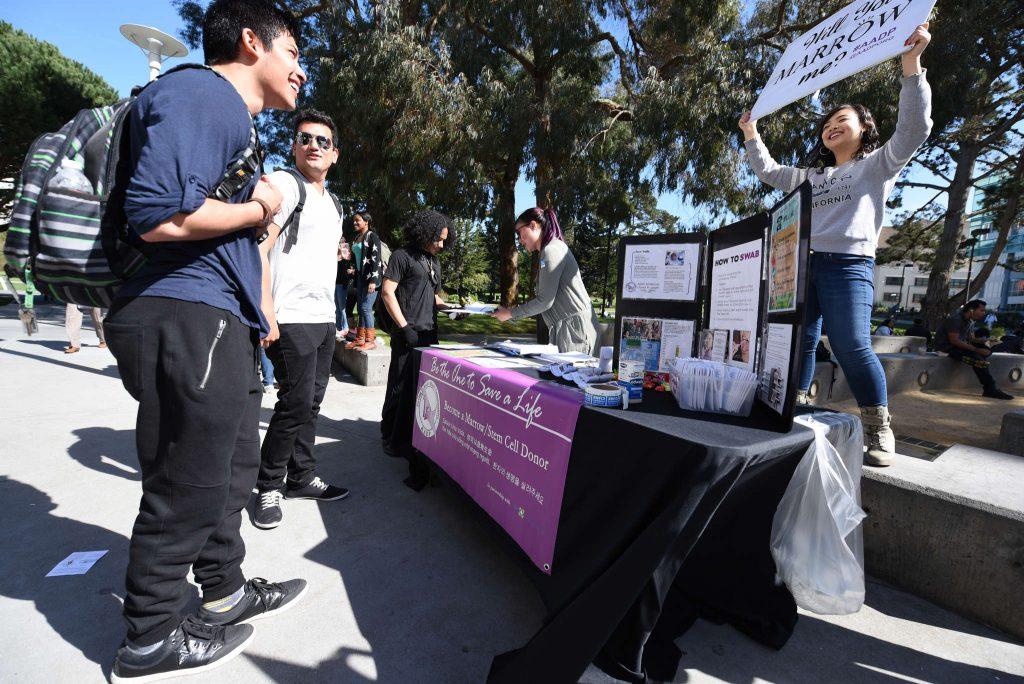Inspired by his cousin who once had leukemia, freshman Arturo Duarte swabbed a tissue sample from his mouth on campus last week as part of the process to register as a bone marrow donor.
Duarte is now on a list of possible donors eligible to donate his marrow or stem cells to a person in need. After seeing a donor help save his cousin’s life, Duarte said he would be excited if he were called upon to donate.
“I definitely would (donate) because you’re saving someone’s life,” Duarte said.
The Asian American Donor Program teamed up with the Asian Student Union Aid at SF State Feb. 25 and 26 and registered over 61 students willing to donate marrow or stem-cells should they be matched up with a patient in need.
Students who participated in the registration joined Be The Match, a global registry that helps match patients with donors from all over the world. Donations take place at hospitals that work with Be The Match and are sent directly to the location of the patient, according to AADP Outreach Coordinator Diana Hong.
Donors’ stem cells and bone marrow go to patients suffering from life-threatening blood cancers, according to the Be The Match website. Hong said each person on the registry has a 1 in 500 chance of being a match for a patient.
If a member of the registry is a match for a patient, they are contacted to be sure they still want to participate in the donation procedure, Hong said.

AADP intern Jina Lee said peripheral blood stem cell donations are the most common, making up 75 percent of all donations. Donors receive an injection to increase the amount of stem cells in the blood in case the receiving patient is much bigger than the donor, Lee said.
“Blood is extracted from one side of the arm and it goes through a filter,” Lee said. “That filters out the stem cells in your blood and the rest of your blood all goes back in your body.”
The second form of donation is marrow collection, which extracts 2 to 3 percent of marrow from the donor’s hip bone, according to Lee. Anesthesia is given to donors beforehand so they do not feel the procedure, however Lee said that donors should expect to wake up a bit sore.
While marrow collection donors can take up to three days to recover, PBSC donors can return to school or work the day after the procedure, Lee said.
The AADP registered 13,918 new members last year, 55 of which found a match and agreed to donate, according to a statistic provided by Hong. Even if none of the students that signed up are a match this year, Lee said they could be contacted up to 40 years from now to donate.
Sophomore Eric Wong-McFaul is among the students that registered as a donor.
“If I can be matched with someone who would otherwise be condemned to pain, suffering or even death, and I can do something about that? Then yeah, I’ll sign up for this,” Wong-McFaul said.
Computer science student Mahelet Gezachew also registered and said she would be willing to donate if called upon.
“You’re saving someone’s life,” Gezachew said. “I personally don’t know anybody with leukemia, but it still helps.”
Freshman Jose Ramirez said that he would jump at the opportunity to be a donor and possibly save a life.
“My mom’s a nurse who’s always been in the medical field, so I definitely see a positive light to this,” Ramirez said. “Especially me being a healthy man, to help those who are not as fortunate.”






MoltonP • Jul 15, 2015 at 7:50 am
I am confident that in order to be more concentrated during the lecture students need some push. Sometimes, while listening to some new information, you feel totally lost but if you get at least some hint beforehand, it will make things much easier. It is like writing of essay, you cannot just sit and write everything from the beginning to end. Like professional writers of DissertationWritingLaboratory you should first make a research, write a plan, possibly sometimes you will need brainstorming to get more ideas and then it is possible to start writing.